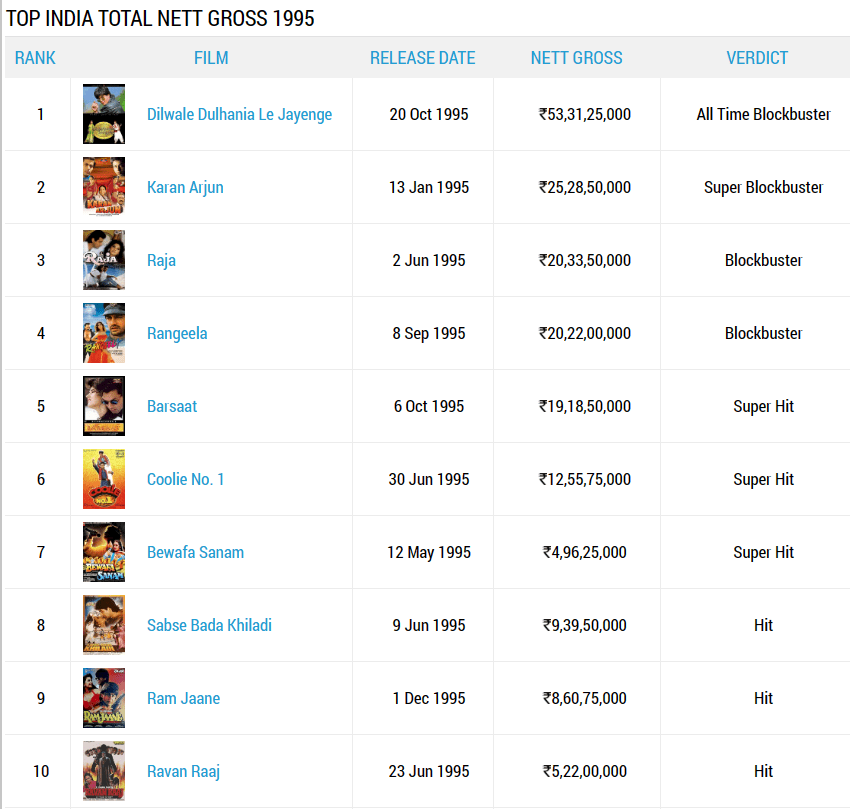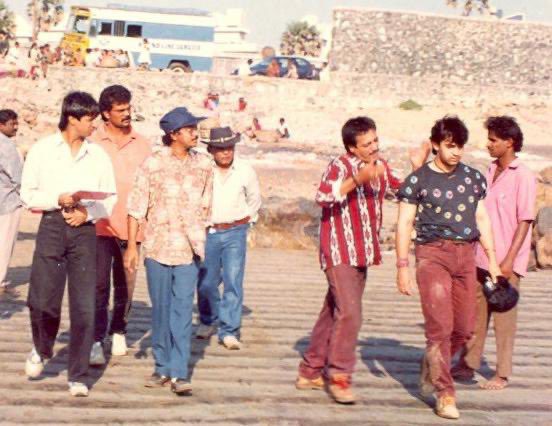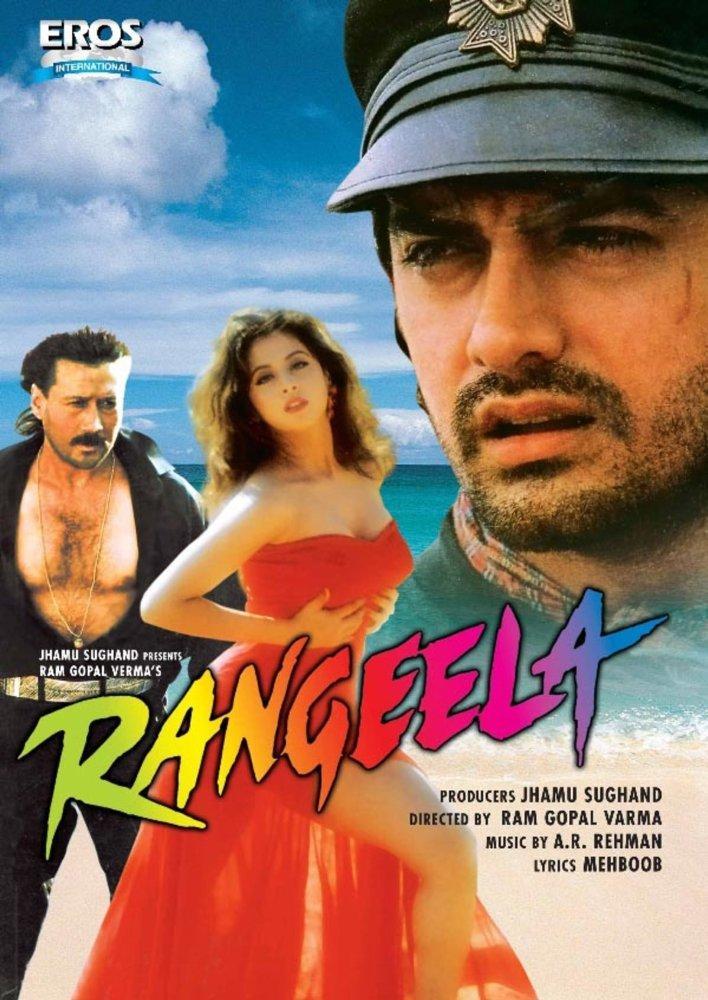Table of Contents
Would you believe me if I told you that Rangeela, a beloved Bollywood film from the ’90s, was inspired by “The Sound of Music”?
Or that a filmmaker renowned for his gritty crime dramas wrote and directed this path-breaking romantic film?
If you aren’t familiar, Rangeela is considered one of the finest Indian musicals ever.
Even today, nearly three decades after its release, the film’s soundtrack, composed by a young A. R. Rahman, continues to resonate with young and old alike.
Yet, it’s not just the music that deserves praise in this film. There are plenty of other highlights as well, which I’ll be covering in this piece — my tribute to the cult classic.
A quick heads up to folks from the West who are reading this piece.
If your only encounter with Indian cinema thus far has been “RRR,” then you’ll be pleasantly surprised by this film. (If you wish to avoid spoilers, head straight to the bottom of this page to watch the movie.)
To my fellow Indians who haven’t seen the movie yet — what are you even doing here?
And lastly, to all the passionate cinephiles out there who have watched and celebrated this movie, let’s relive the magic of Rangeela on its 28th anniversary as I share some of my favorite things about the movie
The enigmatic Urmila Matondkar

In my humble opinion, Indian cinema has had its fair share of struggles when it comes to capturing on-screen glamour.
Just take a look at this picture, for instance. These screen grabs are taken from three iconic music videos in retro Bollywood films.
Can you imagine this was being dished out in the name of glamor in the ’70s and ’80s? Notice the loud attire of the performer and their unintentionally funny-ish dance moves. (Sorry Helen ma’am!)
Things did improve somewhat in the ’90s, but the portrayal of glamour on celluloid was often either cringeworthy or tasteless.
Can you imagine this was being dished out in the name of glamor in the ’70s and ’80s? Notice the loud attire of the performer and their unintentionally funny-ish dance moves. (Sorry Helen ma’am!)

However, Rangeela marked a significant turning point. For the first time, there was a seamless blend of classiness and sensuality, boldness and beauty, minimalism and extravagance. A major contributor to this delicate balance was undoubtedly the film’s leading lady, Urmila Matondkar.
From the very first frame of the movie, where Ms. Matondkar gracefully strutted the streets of Mumbai (then Bombay) in slow motion with the film’s title track playing in the background, to the last, the petite actress held her own alongside heavyweights like Aamir Khan and Jackie Shroff.
Her vibrant presence lit up every scene she was in, and if my math is right, she even got more screen time than her male counterparts in the film.
For the first time, there was a seamless blend of classiness and sensuality, boldness and beauty, minimalism and extravagance.
I’m still in awe of how effortlessly she transitioned from the quintessential girl next door, someone everyone wanted to bring home, to a smoking hot diva in the exquisitely filmed and choreographed song sequences. Speaking of choreography, it’s worth noting that the actress stepped in for the film’s lead choreographer, Saroj Khan, on at least one occasion. It’s a shame that her contributions went uncredited.
Way ahead of its time
Most Indian films, good or bad, fail the Bechdel Test* miserably. The ’90s, in particular, were a low point in this regard. Female leads during that era were often reduced to being the protagonist’s arm candy. In those films, the heroine would typically receive a moral lecture from the hero during their initial encounter (back then, meet cute wasn’t a common trope in movies made in this part of the world).
This antagonism would persist throughout the first act until she ultimately realized that she and the hero were meant to be together, often after enduring relentless harassment or stalking by the leading man.
What I’ve just described was the standard character arc for the leading lady in practically 99.99% of films from that period.
Apart from the occasional powerful solo scene (if lucky), she would usually be seen pining for the hero’s love, playing the role of his loyal sidekick, defending his honor or simply waiting for him to rescue her.
In short, the female lead had no agency!
So what set Rangeela apart?

Rangeela barely passes the Bechdel Test. However, out of the top 10 grossing films of 1995, this film stands out as the lone female-centric entry.
Rangeela defied this norm.
Ms. Matondkar, a relative newcomer in the industry at the time, played the female lead, while the two male superstars, Mr. Khan and Mr. Shroff, played supporting roles.
The movie’s plot revolves around the dream of a female backup dancer — Mili — to make it big in Bollywood, and the director keeps the narrative centered on Mili and her aspirations. There are detours now and then, but the viewer is never pulled away from Mili’s struggles and aspirations, keeping us fully immersed in her rags-to-riches journey throughout the film.As a viewer, you become so invested in Mili’s life that you take vicarious pleasure in her success when you see her (spoiler alert!) seated in the front row at the premiere of her debut film, Rangeela (how meta, right?), toward the climax.
Sublime direction
In the early ’90s, a hotshot director who had already made a name for himself in the Telugu film industry packed his bags and made his way to the City of Dreams to leave his mark in the Hindi film industry.
Rangeela was Ram Gopal Varma’s (a.k.a. RGV) fourth Hindi film but his first foray into the romance genre.
It was a notable departure from his usual fare of gangster dramas and low-budget horror flicks. Yet, when you watch the movie, it’s evident that he’s equally at home in this genre as well.
So what makes this film still feel fresh and contemporary more than two decades later?

Rangeela was Ram Gopal Varma’s (a.k.a. RGV) fourth Hindi film but his first foray into the romance genre.
Well, here’s my take:
- The ending might seem somewhat contrived, but the film thankfully isn’t your typical rich girl falling for a guy from a humble background (or vice versa) story.
- In Indian films, the portrayal of sibling relationships has often been melodramatic to the point of discomfort. However, Rangeela gets the brother-sister dynamic just right — Mili’s banter with her younger brother feels real.
- One of my favorite scenes is Raj Kamal’s, portrayed by Mr. Shroff, flashback. It’s a deft piece of filmmaking: that’s all I’m going to say so as not to spoil the film.
- The movie is peppered with inside jokes about the Hindi film industry. For instance, there’s a character named Steven Kapoor — no coincidence that Kapoor shares his first name with Mr. Spielberg — who believes he’s the world’s greatest living director.
- Lastly, I tip my hat to RGV, an industry outsider at the time, for having the conviction to make such a non-formulaic film right at the beginning of his Bollywood career. If the movie had tanked, it would probably have been curtains for RGV’s Bollywood dreams.
Aamir Khan’s flawless “tapori” avatar
Who can possibly forget the famous “dus ka thees” intro scene of Aamir Khan’s?
For those unfamiliar with the intricacies of Mumbai’s street lingo, let me tell you, it’s no easy feat to pull off convincingly, and very few actors have managed to do it justice on the silver screen.
Despite being cast against type, Mr. Khan immerses himself in the dialect as the wisecracking punk Munna.Known for his dedication to his characters, the actor revealed in a recent interview that he went to great lengths to truly inhabit the role, even going so far as to skip showering for days during filming!
One particularly memorable scene in the movie never fails to crack me up.
It involves Munna, all dressed up, taking Mili on a date to a 5-star hotel. Mr. Khan is so convincingly in character as Munna in that scene that you momentarily forget the suave actor beneath the surface.
Manish Malhotra’s dreamy costumes
The film’s costumes were initially slated to be designed by a prominent designer. However, at the eleventh hour, the designer withdrew but recommended their assistant as a capable replacement. That assistant happened to be none other than Manish Malhotra.
Back then, the man, who has been dressing Indian movie stars for more than two decades now, was relatively unknown. But boy, did he do an absolutely fantastic job in the film.
Remember I mentioned the delicate balance of glamour in the movie in the beginning of this article? If Urmila Matondkar was one essential piece of that puzzle, Mr Malhotra was undoubtedly the other.
His work on Ms. Matondkar’s wardrobe alone was so groundbreaking that I’m pretty sure it added to her performance in the film.
Jackie Shroff, portraying the amiable A-lister, also looked the part. Aamir Khan’s costumes, with the exception of that all-yellow ensemble he wears on the date, lent his character a certain air of authenticity. However, I recently learned that Mr. Khan purchased all of Munna’s clothes from street-side vendors.
In fact, Mr. Khan even revealed in an interview that he would approach random passers-by on the street and buy what they were wearing for the film!
The Mozart of Madras’s magical compositions
Rangeela wouldn’t be what it is if not for A. R. Rahman’s music, period.
The film has seven songs. Let me start with my favorite: “Mangta Hai Kya.”
Even today, this song would seem out of place in a Bollywood film because of its unconventional beats, vocals and lyrics.
It’s no wonder Mr. Khan had reservations about its inclusion in the film.
The way it’s shot and integrated into the film is also pretty special — playing in the movie as Munna goes to meet Mili and finds her rehearsing her routine in an empty studio lot. He questions her about the allure of the film industry, and Mili proceeds to offer him a glimpse of the magic of cinema.
Then there’s the crowd-favorite “Tanha tanha,” which is probably the first song that comes to mind for anyone familiar with the album or the film.
The orchestration, particularly the flute ostinato, Asha Bhosle’s vocals, Urmila Matondkar’s graceful and uninhibited movements, Manish Malhotra’s costumes and the scenic beaches of Goa captured through the lens of W. B. Rao — all contribute to the song’s evergreen popularity.
Here’s an interesting tidbit about one of the songs.
RGV and ARR had flown to Goa with the idea of creating a “sensuous” song for the film.
After a four-day stay, when RGV asked to hear the composition, ARR boldly informed him that he hadn’t composed a single note because he had been too busy watching TV in his hotel room.
RGV was furious!
However, ARR assured him he would have a tune ready within the next few days. That tune eventually became the “Hai Rama” song.
However, ARR assured him he would have a tune ready within the next few days. That tune eventually became the “Hai Rama” song. If ARR is to be believed, this song was inspired by the Hindustani classical background score playing in one of the scenes in “Mughal-e-Azam,” a film he happened to catch during his Goa trip!
Beyond convention
They say, “Fortune favors the brave,” and in the case of Rangeela, this rings especially true.
It took courage on the part of the director to remain steadfast in his vision, even in the face of unconventional choices (too many to list here).
It required boldness from the music composer to push the boundaries and create a unique soundtrack that still continues to delight listeners.
The cast, too, showed their mettle by delivering performances that challenged stereotypes and expectations.
And let’s not forget the producer, Jhamu Sughand, who took the risk of backing a film that may not have been commercially viable on paper.
Thanks to their collective bravery and audacity, we, the audience, have been bestowed with a remarkable piece of entertainment. Rangeela has not only stood the test of time but continues to captivate audiences 28 years after its release, ensuring its place as a timeless classic in the annals of Indian cinema.
WATCH THE MOVIE HERE.
This article was first published on the author’s Medium page. It has been lightly edited for clarity and brevity.
The Bechdel Test, or Bechdel-Wallace Test, sometimes called the Mo Movie Measure or Bechdel Rule is a simple test which names the following three criteria: (1) it has to have at least two women in it, who (2) who talk to each other, about (3) something besides a man.
Source
